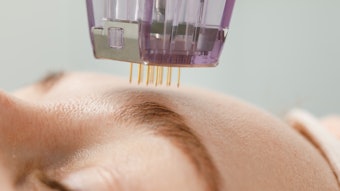
A mouse study comparing the conventional fan-shaped pattern used in barbed thread lifts to a crisscross pattern found better longevity when polydioxanone (PDO)-barbed threads were implanted in the crisscross pattern. The study's findings were published in the Aesthetic Surgery Journal (March 2021).
Researchers implanted three fragments of monofilament PDO-barbed lifting threads in the dorsal skin of 12 nude mice. The pattern of implantation was fan-shaped in the control group and crisscross in the experimental group. Tissue specimens containing tangential areas of threads were harvested, fixed and paraffin-embedded. Samples were histologically analyzed using hematoxylin and eosin, Massons' Trichrome and Sirius red staining. The researchers also analyzed fibrotic areas and the width of fibrosis from the thread.
They found that the fibrous capsulations around the barbed area of the PDO-barbed lifting threads were three-fold greater than those around the barb-free areas of the threads. In the crisscross implantation pattern, width and density of the fibrotic areas were five-fold greater than those of the fan-shaped areas. In addition, induction of fibrous capsules around the PDO-barbed thread was markedly condensed in the crisscross areas.
The authors concluded, "This study provides the basis for more logical implantation pattern in PDO-barbed lifting threads for facial rejuvenation. By generating controlled multiple crisscross patterns, we can create more intense fibrogenesis, reduce tension applied on each barbed thread and, as a result, extend the longevity of the result."











